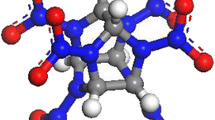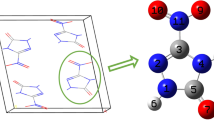Abstract
In this article, the CL-20/HMX cocrystal model was established and its based polymer bonded explosives (PBXs) were designed. The static performances, including mechanical properties, stability and detonation performance of CL-20/HMX cocrystal model and PBXs models, were predicted by molecular dynamics (MD) method. The mechanical parameters, binding energy, and detonation parameters of PBXs models were calculated and compared with that of pure CL-20/HMX cocrystal model. The influence of polymer binders on performances of CL-20/HMX cocrystal explosive was evaluated. Results show that the polymer binders make the engineering moduli (tensile modulus, shear modulus, and bulk modulus) of PBXs declined and Cauchy pressure increased, meaning that the polymer binder can obviously improve mechanical properties of CL-20/HMX cocrystal explosive, and the PBXs model with fluorine rubber (F2311) has the best mechanical properties. In different PBXs models, the binding energy between CL-20, HMX molecules and F2311 is higher than other polymer binders, indicating that the CL-20/HMX/F2311 model is more stable. The PBXs models have lower value of crystal density and detonation parameters compared with pure CL-20/HMX cocrystal and the energetic performance of PBXs is weakened. The PBXs model with fluorine resin (F2314) has the highest energetic performance and it is higher than pure HMX. Therefore, the CL-20/HMX/F2311 and CL-20/HMX/F2314 models have more favorable comprehensive properties, proving that F2311 and F2314 are more preferable and promising to design CL-20/HMX cocrystal based PBXs.







Similar content being viewed by others
Data availability
All data generated or analyzed during this study are included in this article.
Code availability
Not applicable.
Abbreviations
- CL-20:
-
2,4,6,8,10,12-Hexanitro-2,4,6,8,10,12-hexaazaisowurtzitane
- F2311 :
-
Fluorine rubber
- F2314 :
-
Fluorine resin
- HEDMs:
-
High energy density materials
- HMX:
-
Octahydro-1,3,5,7-tetranitro-1,3,5,7-tetrazocine
- HTPB:
-
Hydroxyl terminated polybutadiene
- PBX:
-
Polymer bonded explosive
- PCTFE:
-
Polychlorotrifluoroethylene
- PTFE:
-
Polytetrafluoroethylene
- PVDF:
-
Polyvinylidene difluoride
- RDX:
-
Hexahydro-1,3,5-trinitro-1,3,5-triazine
References
Xu XJ, Xiao HM, Xiao JJ, Zhu W, Huang H, Li JS (2006) Molecular dynamics simulations for pure ε-CL-20 and ε-CL-20-based PBXs. J Phys Chem B 110:7203–7207
Xiao JJ, Ma XF, Zhu W, Huang YC, Xiao HM (2007) Molecular dynamics simulations of polymer-bonded explosives (PBXs): modeling, mechanical properties and their dependence on temperatures and concentrations of binders. Propellants Explos Pyrotech 32:355–359
Qiu L, Xiao HM (2009) Molecular dynamics study of binding energies, mechanical properties, and detonation performances of bicyclo-HMX-based PBXs. J Hazard Mater 164:329–336
Nielsen AT, Chafin AP, Christian SL, Moore DW, Nadler MP, Nissan RA, Vanderah DJ, Gilardi RD, George CF, Flippen-Anderson JL (1998) Synthesis of polyazapolycyclic caged polynitramines. Tetrahedron 54:11793–11812
Agrawal JP (2005) Some new high energy materials and their formulations for specialized applications. Propellants Explos Pyrotech 30:316–328
Simpson RL, Urtiew PA, Ornellas DL, Moody GL, Scribner KJ, Hoffman DM (1997) CL-20 performance exceeds that of HMX and its sensitivity is moderate. Propellants Explos Pyrotech 22:249–255
Sikder AK, Sikder N (2004) A review of advanced high performance, insensitive and thermal stable energetic materials emerging for military and space applications. J Hazard Mater A 112:1–15
Bolton O, Simke LR, Pagoria PF, Matzger AJ (2012) High power explosive with good sensitivity: a 2:1 cocrystal of CL-20:HMX. Cryst Growth Des 12:4311–4314
Badgujar DM, Talawar MB, Asthana SN, Mahulikar PP (2008) Advances in science and technology of modern energetic materials: an overview. J Hazard Mater 151:289–305
Xie HM, Zhu WH (2020) Thermal decomposition mechanisms of the energetic benzotrifuroxan:1,3,3-trinitroazetidine cocrystal using ab initio molecular dynamics simulations. J Chin Chem Soc 67:218–226
Xiao JJ, Zhao L, Zhu W, Chen J, Ji GF, Zhao F, Wu Q, Xiao HM (2012) Molecular dynamics study on the relationships of modeling, structural and energy properties with sensitivity for RDX-based PBXs. Sci China Chem 55:2587–2594
Abou-Rachid H, Lussier LS, Ringuette S (2008) On the correlation between miscibility and solubility properties of energetic plasticizers/polymer blends: modeling and simulation studies. Propellants Explos Pyrotech 33:301–310
Cui HL, Ji GF, Chen XR, Wei DQ (2013) Mesoscopic simulation of aggregate behaviour of polymers in β-HMX-based PBXs. Chin J Chem Phys 26:462–466
Liu ZC, Zhu WH, Ji GF, Song KF, Xiao HM (2017) Decomposition mechanisms of α-octahydro-l,3,5,7-tetranitro-l,3,5,7-tetrazocine nanoparticles at high temperatures. J Phys Chem C 121:7728–7740
Liu ZC, Zhu WH, Xiao HM (2016) Surface-induced energetics, electronic structure, and vibrational properties of β-HMX nanoparticles: a computational study. J Phys Chem C 120:27182–27191
Ren CX, Liu H, Li XX, Guo L (2020) Decomposition mechanism scenarios of CL-20 co-crystals revealed by ReaxFF molecular dynamics: similarities and differences. Phys Chem Chem Phys 22:2827–2840
Mathieu D, Borges I (2022) Molecular dynamics simulation of hot spot formation and chemical reactions. Theor Comput Chem 22:255–289
Mathieu D (2022) Molecular modeling of the sensitivities of energetic materials. Theor Comput Chem 22:2–471
Sun H, Ren PJ, Fried R (1998) The COMPASS force field: parameterization and validation for phosphazenes. Comput Theor Polym Sci 8:229–246
Michael JM, Sun H, Rigby D (2004) Development and validation of COMPASS force field parameters for molecules with aliphatic azide chains. J Comput Chem 25:61–71
Xu XJ, Xiao JJ, Huang H, Li JS, Xiao HM (2010) Molecular dynamic simulations on the structures and properties of ε-CL-20(0 0 1)/F2314 PBX. J Hazard Mater 175:423–428
Xiao JJ, Wang WR, Chen J, Ji GF, Zhu W, Xiao HM (2012) Study on the relations of sensitivity with energy properties for HMX and HMX-based PBXs by molecular dynamics simulation. Physica B 407:3504–3509
Sun T, Xiao JJ, Liu Q, Zhao F, Xiao HM (2014) Comparative study on structure, energetic and mechanical properties of a ε-CL-20/HMX cocrystal and its composite with molecular dynamics simulation. J Mater Chem A 2:13898–13904
Tao J, Wang XF, Zhao SX, Diao XQ, Wang CL, Han ZX (2016) Molecular dynamics simulation of CL-20/HMX cocrystal and blends. Chin J Energ Mater 24:324–330
Andersen HC (1980) Molecular dynamics simulations at constant pressure and/or temperature. J Chem Phys 72:2384–2393
Parrinello M, Rahman A (1981) Polymorphic transitions in single crystals: a new molecular dynamics method. J Appl Phys 52:7182–7190
Allen MP, Tildesley DJ (1987) Computer simulation of liquids. Oxford University Press, Oxford
Ewald PP (1921) Evaluation of optical and electrostatic lattice potentials. Ann Phys 64:253–287
Sun H (1994) Force field for computation of conformational energies, structures, and vibrational frequencies of aromatic polyesters. J Comput Chem 15:752–768
Casewit CJ, Colwell KS, Rappé AK (1992) Application of a universal force field to organic molecules. J Am Chem Soc 114:10035–10046
Mayo SL, Olafson BD, Goddard WA III (1990) Dreiding: a generic force field for molecular simulations. J Phys Chem B 94:8897–8909
Pugh SF (1954) Relations between the elastic moduli and the plastic properties of polycrystalline pure metals. Philos Mag 45:823–843
Pettifor DG (1992) Theoretical predictions of structure and related properties of intermetallics. Mater Sci Technol 8:345–349
Weiner JH (1983) Statistical mechanics of elasticity. John Wiley, New York
Wu JL (1993) Mechanics of elasticity. Tongji University Press, Shanghai
Watt JP, Davies GF, O’Connell RJ (1976) The elastic properties of composite materials. Rev Geophys Space Phys 14:541–563
Guo YX, Zhang HS (1983) Nitrogen equivalent coefficient and revised nitrogen equivalent coefficient equations for calculating detonation properties of explosives: detonation velocity of explosives. Explos Shock Waves 3:57–65
Hang GY, Wang JT, Wang T, Shen HM, Yu WL (2022) Theoretical investigations on stability, sensitivity, energetic performance, and mechanical properties of CL-20/TNAD cocrystal explosive by molecular dynamics method. J Mol Model 28:58
Hang GY, Yu WL, Wang T, Wang JT (2019) Theoretical investigations into effects of adulteration crystal defect on properties of HMX by molecular dynamics method. Theor Chem Acc 138:33
Miao S, Zhang L, Wang T, Wang YL, Hang GY, Mei ZS (2018) Molecular dynamics study on effects of RDX dopants on properties of HMX. Chin J Energ Mater 26:828–834
Miao S, Wang T, Wang YL, Hang GY, Qi CB, Lu CB (2019) Theoretical calculation of the effect of crystal defects on properties of HMX-based PBX. Chin J Energ Mater 27:636–643
Tao J, Wang XF, Zhao SX, Han ZX, Li WH, Wang CL, Huang YF, Fang W (2017) Theoretical calculation of the random interaction and co-crystal interaction of CL-20/HMX. Chin J Explos Propellants 40:50–55
Funding
This research was supported by Young Talent Fund of University Association for Science and Technology in Shaanxi, China (grant number 20200604).
Author information
Authors and Affiliations
Contributions
Gui-yun HANG: Investigation, methodology, and writing-original draft.
Tao WANG: Investigation, and software.
Jin-tao WANG: Conceptualization, and data curation.
Wen-li YU: Visualization, and validation.
Hui-ming SHEN: Modeling, and simulation.
Corresponding author
Ethics declarations
Conflict of interest
The authors declare no competing interests.
Additional information
Publisher's note
Springer Nature remains neutral with regard to jurisdictional claims in published maps and institutional affiliations.
Rights and permissions
Springer Nature or its licensor (e.g. a society or other partner) holds exclusive rights to this article under a publishing agreement with the author(s) or other rightsholder(s); author self-archiving of the accepted manuscript version of this article is solely governed by the terms of such publishing agreement and applicable law.
About this article
Cite this article
Hang, Gy., Wang, T., Wang, Jt. et al. Theoretical research on performances of CL-20/HMX cocrystal explosive and its based polymer bonded explosives (PBXs) by molecular dynamics method. J Mol Model 28, 385 (2022). https://doi.org/10.1007/s00894-022-05380-9
Received:
Accepted:
Published:
DOI: https://doi.org/10.1007/s00894-022-05380-9




